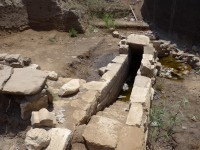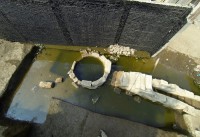 Workers digging a water pump station in the ancient city of Thmuis discovered an ancient nilometer, a structure used to determine the water level of the Nile River. A team of American and Egyptian archaeologists from the University of Hawaii and the Alexandria Center for Hellenistic Studies have excavated the find and believe it dates to the 3rd century B.C. when Thmuis was an important city under the Ptolemies. Fewer than two dozen ancient nilometers have been found in Egypt, making this a very rare find.
Workers digging a water pump station in the ancient city of Thmuis discovered an ancient nilometer, a structure used to determine the water level of the Nile River. A team of American and Egyptian archaeologists from the University of Hawaii and the Alexandria Center for Hellenistic Studies have excavated the find and believe it dates to the 3rd century B.C. when Thmuis was an important city under the Ptolemies. Fewer than two dozen ancient nilometers have been found in Egypt, making this a very rare find.
Thmuis, near the present-day city of El-Mansoura in Lower Egypt’s Nile Delta, flourished as port city from the 4th to 1st century B.C. It became the regional capital of the nome of Kha when the course of the Nile shifted from Mendes, a famous city in antiquity which had briefly been the capital of Egypt in the early 4th century B.C. under the reign of 29th Dynasty Pharaoh Nepherites. Located just half a kilometer north of Thmuis, in the 4th and 3rd centuries Mendes began to lose population as its branch of the Nile silted over and the river that was the lifeblood of Egypt moved to Thmuis. The people followed the Nile, abandoning the ancient capital for the new one.
Situated on an eastern branch of the Nile next to Daqahliyyah Lake bordering on the Mediterranean Sea, Thmuis became an important hub of agriculture, trade and religion in the region. In the Roman era, it was of significant military importance as well. The Romano-Jewish historian Flavius Josephus reported in The Wars of the Jews that Titus, son of the new emperor Vespasian, brought his legions to Thmuis on a fleet of long ships. He moored the ships there and marched across the Sinai Peninsula to Cesarea before laying siege to Jerusalem in early 70 A.D. during the First Jewish–Roman War.
 In December of 2012, an archaeological team sponsored by the National Geographic Society began excavating an area of Thmuis where monumental architectural features, possibly the remains of a temple built by Ptolemy II Philadelphus (r. 283-246 B.C.) for his sister-wife Arsinoë II, had been discovered a few years earlier. The temple complex was on the banks of the Nile. Archaeologists believe the nilometer was part of this temple. Its discovery confirms that the Nile channel ran along the western side of Thmuis.
In December of 2012, an archaeological team sponsored by the National Geographic Society began excavating an area of Thmuis where monumental architectural features, possibly the remains of a temple built by Ptolemy II Philadelphus (r. 283-246 B.C.) for his sister-wife Arsinoë II, had been discovered a few years earlier. The temple complex was on the banks of the Nile. Archaeologists believe the nilometer was part of this temple. Its discovery confirms that the Nile channel ran along the western side of Thmuis.
Priests used the nilometer to predict the extent of the annual flooding of the Nile.
Made from large limestone blocks, the nilometer was a circular well roughly eight feet (2.4 meters) in diameter with a staircase leading down into its interior. Either a channel would have connected the well to the river, or it would have simply measured the water table as a proxy for the strength of the river. Seven cubits — roughly 10 feet (3.04 meters) — was the optimum height for prosperity.
“During the time of the pharaohs, the nilometer was used to compute the levy of taxes, and this was also likely the case during the Hellenistic period,” says Robert Littman, an archaeologist at the University of Hawaii. “If the water level indicated there would be a strong harvest, taxes would be higher.”
 Because a weak flood meant there would be famine and an excessive one destroyed homes and drowned fields, predicting how far the waters would overflow was a matter of life and death. Thmuis residents brought offerings to the temple in the hope of winning the favor of the Nile River god. There’s a list of Greek names and associated numbers on one of the limestone blocks. Archaeologists believe they were sponsors who donated money for the construction of the nilometer.
Because a weak flood meant there would be famine and an excessive one destroyed homes and drowned fields, predicting how far the waters would overflow was a matter of life and death. Thmuis residents brought offerings to the temple in the hope of winning the favor of the Nile River god. There’s a list of Greek names and associated numbers on one of the limestone blocks. Archaeologists believe they were sponsors who donated money for the construction of the nilometer.
It was in use for about 1,000 years before the course of the Nile shifted again, leaving Thmuis to suffer the depopulation that Mendes had suffered before it. Today it’s a small village, but the Nile’s ancient presence is still felt in the high water table, high enough to make it worthwhile to dig the well that unearthed the nilometer.